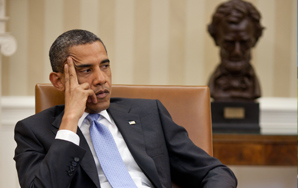Is Obama Too Sane To Be Great?
This is ironic, considering the two leaders Obama invoked most often during the 2008 presidential campaign were Lincoln and King—both of whom suffered from mental illness. (Lincoln suffered from chronic depression all throughout his life; King attempted suicide twice during his adolescence, and experienced periods of depression and mania throughout his adult life.)

People have long recognized the connection between great art and mental illness. In Plato’s dialogue Ion, Socrates says that if “any man come to the gates of poetry without the madness of the Muses… then shall he and his works of sanity with him be brought to naught by the poetry of madness…” And indeed, a rundown of the greatest artists of the last several hundred years—from John Keats to Kurt Cobain—occasionally resembles a who’s-who list of the mentally maladjusted and the chronically depressed.
But might there be a similar connection between great leadership and mental illness? And if so, is it possible that President Barack Obama—in light of what we’ve seen of his leadership style so far—is too sane to be a great president?
Too sane? you may ask. What an odd question. What does sanity have to do with great leadership? Well, according to one Harvard psychologist, perhaps more than you think.
In his recent book A First-Rate Madness: Uncovering the Links Between Leadership and Mental Illness, Harvard psychology professor Nassir Ghaemi makes the provocative argument that in times of crisis, leaders with a touch of mental illness are preferable to leaders who are, by modern clinical standards, mentally healthy. Specifically, Ghaemi believes that mental illness often confers its sufferers with four traits that are especially useful during times of crisis: realism, resilience, empathy, and creativity. Ghaemi’s argument is all the more compelling when one takes a quick glance at the list of leaders he profiles in his book, all of whom suffered from mental illness in one form or another: Abraham Lincoln, Franklin D. Roosevelt, Winston Churchill, John F. Kennedy, William Tecumseh Sherman, Ted Turner, Mohandas Gandhi, and Martin Luther King, Jr.
According to Ghaemi, mentally healthy leaders tend to be overly optimistic and too trusting, often underestimating the dangers of a potential enemy—think British Prime Minister Neville Chamberlain, who in 1938 signed the Munich Agreement and assured England that the world had nothing to fear from Adolph Hitler. By contrast, leaders with a touch of mental illness tend to be less optimistic and more discerning when it comes to potential threats, owing to what Ghaemi calls “depressive realism”—a quality that apparently Lincoln and Churchill had in spades.
Mentally healthy leaders tend to be less resilient when faced with a crisis, and less capable of inspiring resilience in others—compare Lyndon Johnson’s leadership during the Vietnam War versus FDR’s leadership during World War II.
Mentally healthy leaders also tend to be less creative (think Richard Nixon) and less emphatic (think George W. Bush). By contrast, few would deny that Gandhi and King were among the most creative and emphatic leaders in the history of the modern world.
This is not to say that mental illness instantly translates into admirable leadership qualities (Ghaemi argues that Hitler and Stalin also suffered from mental illness). Nor is it to romanticize mental illness, or deny its often crippling and harrowing effects. However, Ghaemi’s main thesis is a startling reversal of conventional wisdom regarding mental health and its relationship to leadership: that in times of crisis, society is much better off being led by someone’s who’s a little crazy than someone who’s far too sane.
Reading Ghaemi’s book, I was reminded of an excellent blog post I read awhile back by Ben Horowitz, former CEO of Opsware and a prominent venture capitalist. In his post entitled “Peacetime CEO/Wartime CEO,” Horowitz outlines the fundamental differences between a leader who steers the ship during times of peace, versus one who must steer it during the turbulent, existentially perilous times of war. According to Horowitz:
Peacetime CEO knows that proper protocol leads to winning. Wartime CEO violates protocol in order to win…
Peacetime CEO always has a contingency plan. Wartime CEO knows that sometimes you gotta roll a hard six…
Peacetime CEO knows what to do with a big advantage. Wartime CEO is paranoid…
Peacetime CEO does not raise her voice. Wartime CEO rarely speaks in a normal tone…
Peacetime CEO trains her employees to ensure satisfaction and career development.
Wartime CEO trains her employees so they don’t get their ass shot off in the battle…
As Horowitz makes clear, wartime leadership requires a modus operandi fundamentally different from peacetime leadership. The peacetime CEO is calm, stable, optimistic, and more or less sane. The wartime CEO is restless, unstable, slightly paranoid, and a little crazy.
Which brings us back to Obama. Much of Obama’s appeal during the 2008 presidential campaign, apart from his stirring rhetoric, rested in the image of sanity and reasonableness he presented to the public. In contrast to Cowboy George W., here was No Drama Obama: a thinker, a scholar, someone who would lead with his head, not his gut; who would reach across the aisle to bring Democrats and Republicans together; who didn’t see red states or blue states but the United States (which, presumably, is one big ideological shade of purple). If Bush had been the Decider, Obama would be the Uniter, ushering in a new era of hope and change and post-partisan politics.
All of which might’ve worked—if he’d been elected during a time of peace and stability.
He wasn’t.

